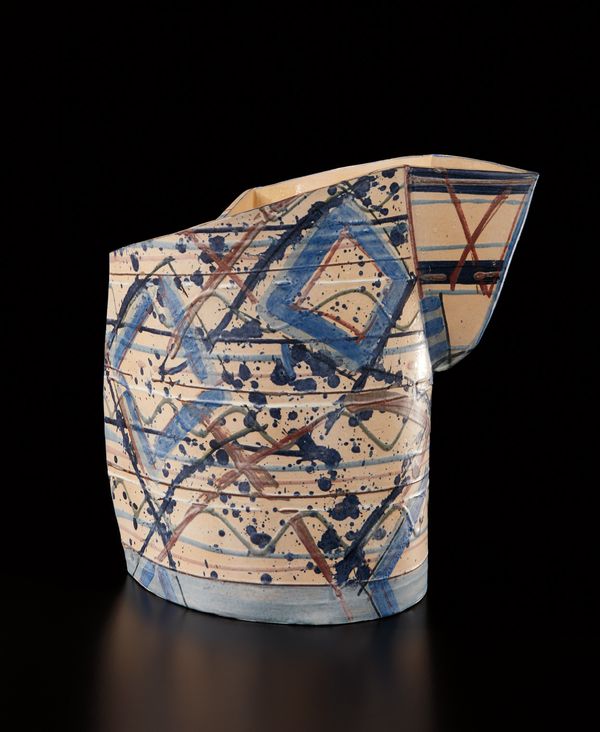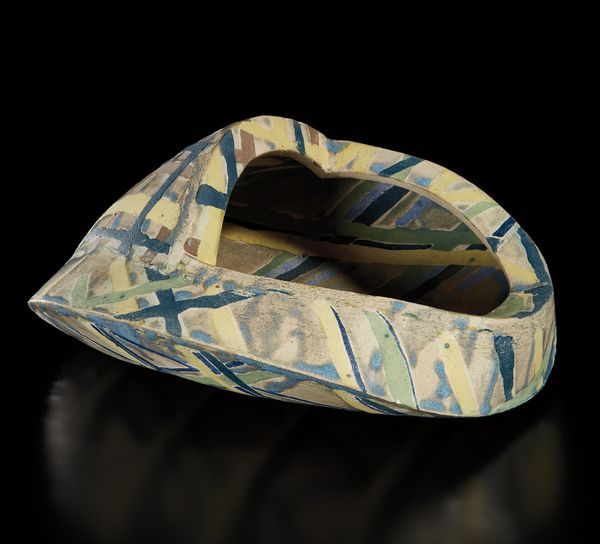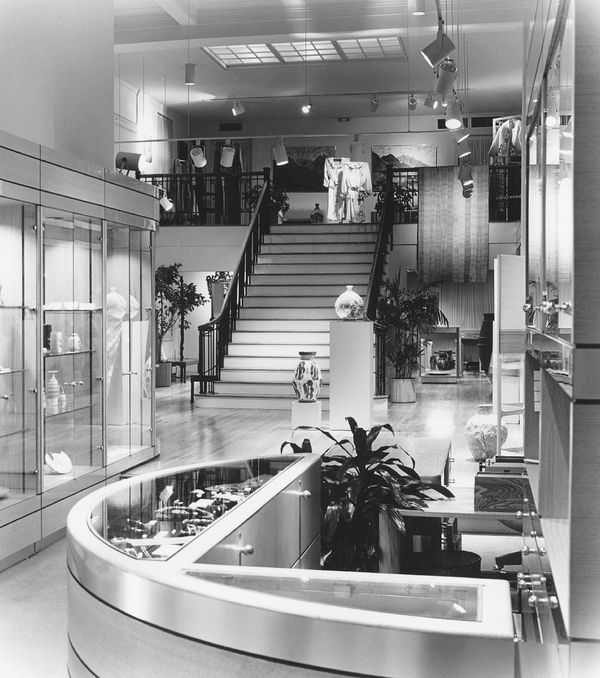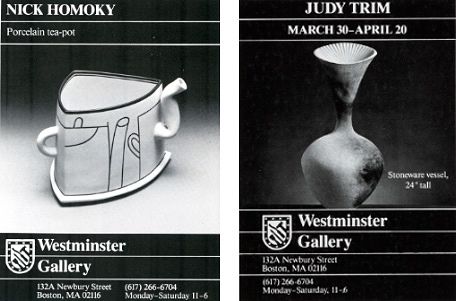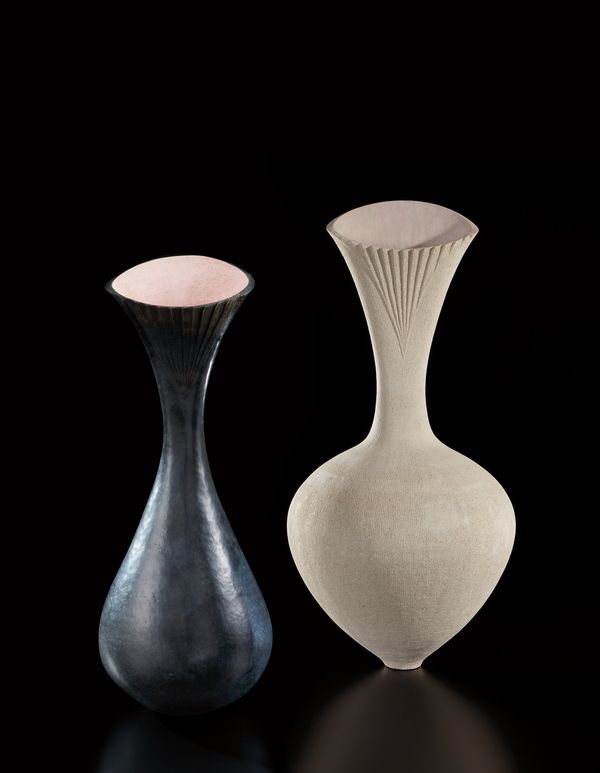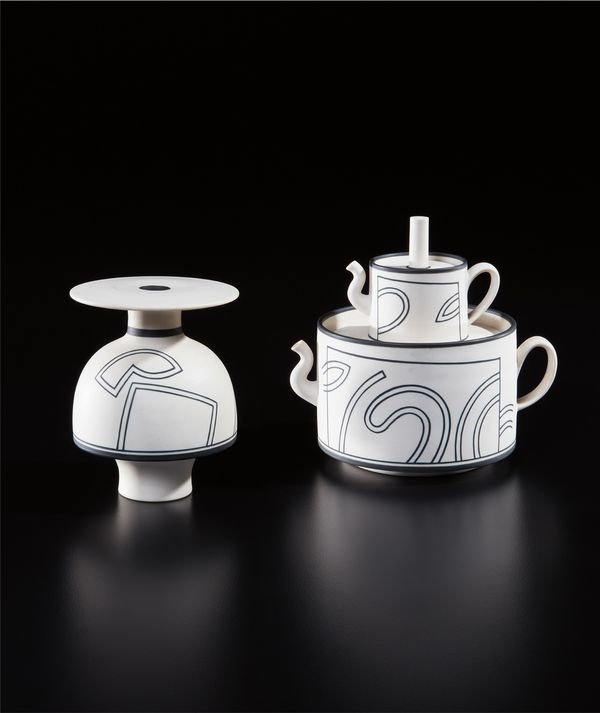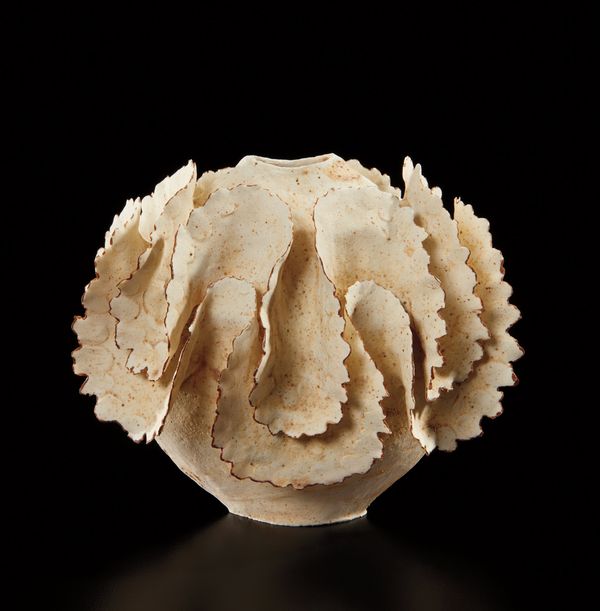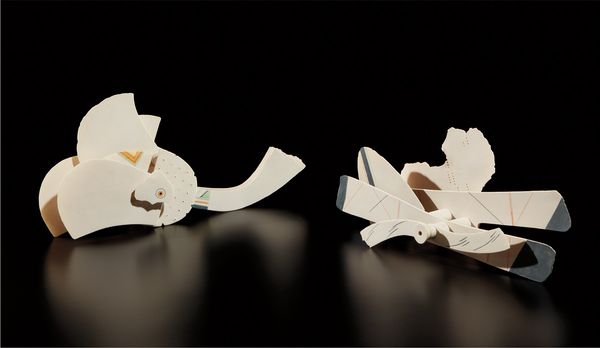Nicholas Homoky Vase and double teapot, circa 1983
By Glenn Adamson, Senior Research Scholar, Yale Center for British Art
For certain artistic disciplines, the 1980s were the best of times. Music video, for example: MTV launched in 1981. Graffiti was at its height. So was postmodern architecture. It was also, arguably, a great era for fashion (depending on your opinion of shoulder pads). And then there's another medium that absolutely thrived in the '80s, though comparatively few were aware of it: studio ceramics.
Between the years 1980 and 1987, when the Westminster Gallery was operating in Boston, the medium of clay was undergoing an extraordinary period of artistic exploration. In the United States, successive generations of university-trained potters had built up programs of great breadth and depth. It was a golden age of patronage, with both private collectors and museums building deep holdings. And Westminster was far from alone in representing this material in the market. Garth Clark in New York, Helen Drutt in Philadelphia, Ruth Braunstein in San Francisco and many other dealers were assiduously promoting ceramics as a vital art form.
For all the American scene's vitality though, it was arguably in Britain that the most electric artistic development was occurring. As so often, the energy came from a generational conflict. The great figures who had come of age at midcentury were still working, and in some cases, still in their primes. Bernard Leach, a revivalist who regarded historic English slipwares and Asian celadons as standards to emulate, had died in 1979; his most talented and influential acolyte, Michael Cardew, passed in 1983. But there were still many others following the prescriptive pathway of traditional pottery, among them stellar talents like Clive Bowen and Richard Batterham.
Alongside these historicist-minded potters were determined modernists, who drew their inspiration from European design and abstract art. Preeminent among them, of course, was Lucie Rie, whose superlative mastery has justly made her famous far outside ceramic circles. Though an octogenarian by the 1980s, she was still making some of her finest works, thanks to her steady perfection of tinted glazes and her increasingly daring silhouettes, with just a slight hint of exaggeration about them.
Rie's onetime studio mate and kindred spirit Hans Coper tragically died in 1981, just a little over sixty years of age, but his pots still resonated powerfully for all working in clay. With volumes alternately attenuated or swelled into ample plenitude, his works seemed monumental in every way, even when only a few inches high.
And then there was Gordon Baldwin. Restlessly inventive, yet beautifully resolved, his pots (like Coper's) bear legitimate comparison to the sculptures of Brancusi; where base ends and primary form begins is hard to say. Yet his forms were also articulated with gestural marks in the manner of Abstract Expressionist painting. By fusing these very different sources in modern art, Baldwin forged a ceramic idiom of extraordinary interest and power.
From top: Alison Britton "Big Blue Pot," circa 1983; Jacqueline Poncelet Slab-built form, circa 1981
Younger potters who came of age at this time, then, faced a stark opposition: on one hand, an earthy vernacular; on the other, an accomplished formalism. They reacted by choosing neither. Instead, they looked away from the medium, to inspirations elsewhere in the arts (among them, music, graffiti, architecture and fashion). They also looked back, not to Leach's worthy traditions, but to an eclectic mix of other historic sources, among them patterned textiles. The best of them, like Jacqueline Poncelet and Alison Britton—who both studied at the Royal College of Art in the late 1970s—also thought deeply about the discipline's metaphorical registers. They continued to make vessels but regarded them as "double coded" objects (much as Charles Jencks was describing postmodernist buildings). These were not quite functional objects, but objects about functionality, and the role that it plays in everyday life. They attended to the vessel's ritual implications—the grandeur implied by an act of pouring out, for example. They aimed not for the assured gravitas of Rie, Coper and Baldwin, but a complex involution that was entirely their own.
These were not quite functional objects, but objects about functionality, and the role that it plays in everyday life.
Interior of Westminster Gallery, circa 1980; two Westminster Gallery advertisements from 1984 and 1985 featuring Nicholas Homoky and Judy Trim. Courtesy of the American Craft Council Library and Archives.
One of the key issues that arose at this time—in part because ceramics were now being beautifully photographed in color, and promoted in glossy magazines—was the relationship between the object and its image. Elizabeth Fritsch, one of the key innovators of the time, made what she called "optical pots" in which the very form seemed to collapse into an act of pure self-representation. Judy Trim's strongly delineated vases come close to Fritsch's idiom; it's as if they had sprung to life from a drafting table, the ceramic equivalent of Who Framed Roger Rabbit? This same play between two- and three-dimensionality also marks the porcelains of Nicholas Homoky, which bear diagrammatic outlines on their surfaces, as if they were yet to be cut out and assembled into useful form.
From top: Judy Trim Two tall vases, 1980s; Nicholas Homoky Vase and double teapot, circa 1983
In any period, there are always a few figures who go their own way. One of these in the 1980s was Ursula Morley-Price, who was born in Britain and took original inspiration from Leach, but then moved to France, positioning herself outside the studio pottery scene of her home country. Her distinctive flanged forms have a delicacy that would not look out of place encrusting a coral reef. By gently spiraling the thin wings projecting from the vessel form, she created a sense of upward movement.
Ursula Morley-Price Winged vase form, circa 1985
Another individualist was Eileen Nisbet, who was (along with Homoky) one of few British potters to take up porcelain as a primary material, beginning in 1975. Exploiting the translucency of this hard, fine clay body, she created thin planar objects, typically uncolored, and sometimes illuminated them on display. In the early 1980s she became entranced with the forms of aircraft wings and propellers and made a series on them; as critic Peter Lane observed, "even though the object has no power to move, it might appear to have just alighted or be about to take off."
Eileen Nisbet Two "Aeroplane" sculptures, 1980s
Monica Young was an exact contemporary of Nisbet's (both were born in 1929) and had a biography that mirrored Morley-Price's, as she was born in Paris and moved to England when young. Self-taught and working in a remote Yorkshire locale, she developed pot forms of striking simplicity, usually based around a single overlapping fold. One might expect these organic shapes to have been achieved through slab construction (that is, the manipulation of a rolled clay sheet), but, in fact, she coiled her pots, often to impressive heights, then carved them into final shape.
Fast forward to today, however, and the raw energy of the '80s is back. Ceramics has achieved unprecedented currency in the fine art context...
The fervor of experiment that marked British pottery in the 1980s proved to be short-lived. Some of the key figures of that time, notably Alison Britton, did continue to explore the disjunctive and allusive aesthetics that emerged in the postmodern era, finding them to be endless wells of possibility. Others, like Jacqueline Poncelet, migrated into other media. In the 1990s, potters like Edmund DeWaal, Julian Stair and Magdalene Odundo established a new classicism in the discipline, abandoning the edginess of the preceding decade and opting instead for a stately and mature simplicity.
Fast forward to today, however, and the raw energy of the '80s is back. Ceramics has achieved unprecedented currency in the fine art context, with many newly drawn to the medium, and others who have long worked in the discipline finally receiving overdue attention. The present tendency is toward freshness in color and touch, a direct encounter with the clay. At this time of renewed possibility for the ceramics, it seems worth looking back to the 1980s, and to the legacy of Westminster Gallery in particular. It just so happens that I lived in suburban Boston at the time; unfortunately, I was only in high school, and it was mainly the music videos and shoulder pads that I noticed. Little did I realize that just a short subway ride away was an outpost of extraordinary creative spirit.
Like a lot of people back then, I just didn't know what I was missing.

